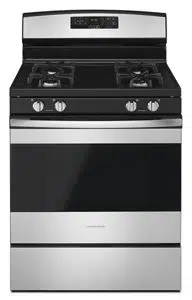Documents: Go to download!
User Manual
- User Manual - (English, French)
- dimension - (English)
- warranty - (English)
- installation guide - (English)
- spec sheet - (English)
- FEATURE GUIDE
- COOKTOP USE
- OVEN USE
- RANGE CARE
- TROUBLESHOOTING
Table of contents
Use Manual Electric Range
FEATURE GUIDE

OVEN LIGHT
Oven cavity light: While the oven door is closed, press OVEN LIGHT to turn the light on and off. The oven light will come on when the oven door is opened. The oven light will not come on during the Self-Cleaning cycle.
CLEAN (on some models)
Self-Cleaning cycle
See the “Self-Cleaning Cycle” section.
CONTROL LOCK (Hold 3 Sec)
Oven control lockout
- Check that the oven is OFF.
- Press and hold CONTROL LOCK for 3 seconds.
- A tone will sound and a lock will be displayed.
- Repeat to unlock. No keypads will function with the controls locked.
CLOCK
Clock:
The Clock uses a 12-hour cycle.
- Check that the oven is OFF.
- Press CLOCK.
- Press the Temp/Time “up” or “down” arrow keypad to set the hours. Press CLOCK to switch to the minutes. Press the Temp/Time “up” or “down” arrow keypad to set the minutes.
- Press CLOCK or START
TIMER SET•OFF
Oven timer:
The Timer can be set in hours or minutes up to 9 hours and 59 minutes.
- Press TIMER SET•OFF.
- Press the Temp/Time “up” or “down” arrow keypad to set the length of time.
- Press START to begin the countdown. If enabled, end-of-cycle tones will sound at end of countdown.
- Press TIMER SET•OFF to cancel the Timer. Do not press OFF/CANCEL because the oven will turn off.
BAKE
Baking and roasting
- Press BAKE.
- Press the Temp/Time “up” or “down” arrow keypad until desired temperature is reached. A tone will sound if the minimum or maximum temperature is reached.
- Press START.
- To change the temperature, repeat Step 2. Press START.
- Press OFF/CANCEL when finished.
BAKE ASSIST TEMPS
Baking and roasting
- Press the desired Bake Assist Temp keypad.
- Press the Temp/Time “up” or “down” arrow keypad to set a temperature other than the Bake Assist Temperature. A tone will sound if the minimum or maximum temperature is reached.
- Press START.
- Press OFF/CANCEL when finished.
BROIL
Broiling:
- Position cookware in the oven and close the oven door.
- Press BROIL.
- Press the Temp/Time “up” or “down” arrow keypad until desired temperature is reached. A tone will sound if the minimum or maximum temperature is reached.
- Press START.
- To change the temperature, repeat Step 3 and press START.
- Press OFF/CANCEL when finished
WARM
Hold warm
Food must be at serving temperature before placing it in the warmed oven.
- Press WARM.
- Press the Temp/Time “up” or “down” arrow keypad until desired temperature is reached. A tone will sound if the minimum or maximum temperature is reached.
- Press START.
- Press OFF/CANCEL when finished. NOTE: The oven will automatically turn off after 60 minutes.
START
Cooking start: The Start keypad begins any oven function. If Start is not pressed within 10 seconds, a tone will sound and Start will blink until pressed or canceled. If Start is not pressed within 30 seconds after pressing a keypad, the function is canceled and the time of day is displayed.
OFF/CANCEL
Range function: The Off/Cancel keypad stops any function except the Timer and Oven Control Lockout.
TEMP/TIME
Temperature and time adjust: The Temp/Time “up” and “down” arrow keypads are used to adjust time and temperature settings.
COOKTOP USE
 WARNING: Fire Hazard
WARNING: Fire Hazard
Turn off all controls when done cooking.
Failure to do so can result in death or fire.

Electric igniters automatically light the surface burners when control knobs are turned to LITE.
Before setting a control knob, place filled cookware on the grate. Do not operate a burner using empty cookware or without cookware on the grate.
The flame should be adjusted so it does not extend beyond the edge of the pan.
To Set:
- Push in and turn knob counterclockwise to LITE.
IMPORTANT: All surface burners will click. Only the burner with the control knob turned to LITE will produce a flame. - Turn knob to anywhere between High and Low.
REMEMBER: When range is in use or (on some models) during the Self-Cleaning cycle, the entire cooktop area may become hot
Power Failure
In case of prolonged power failure, the surface burners can be lit manually. Hold a lit match near a burner, and then turn knob counterclockwise to LITE. After burner lights, turn knob to setting.
Sealed Surface Burners
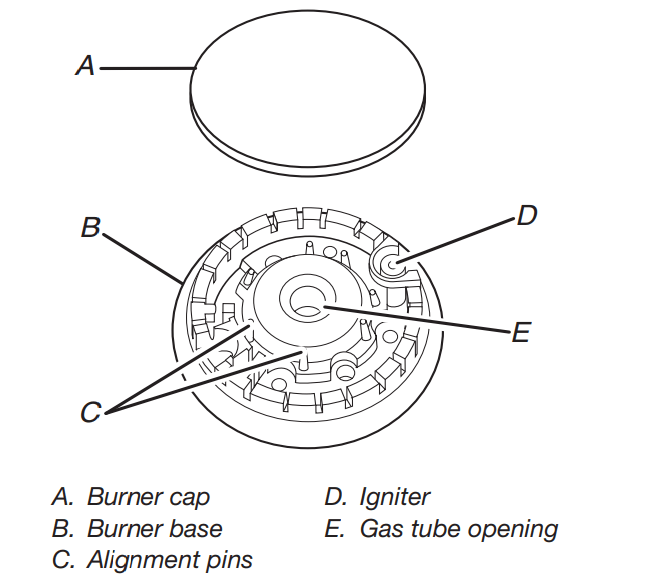
Burner Cap: Always keep the burner cap in place when using a surface burner. A clean burner cap will help avoid poor ignition and uneven flames. Always clean the burner cap after a spillover and routinely remove and clean the caps according to the “General Cleaning” section.
Gas Tube Opening: Gas must flow freely throughout the gas tube opening for the burner to light properly. Keep this area free of soil and do not allow spills, food, cleaning agents, or any other material to enter the gas tube opening. Keep spillovers out of the gas tube opening by always using a burner cap.

Burner Ports: Check burner flames occasionally for proper size and shape as shown in the previous illustration. A good flame is blue in color, not yellow. Keep this area free of soil and do not allow spills, food, cleaning agents, or any other material to enter the burner ports.
To Clean:
IMPORTANT: Before cleaning, make sure all controls are OFF and the cooktop is cool. Do not use oven cleaners, bleach, or rust removers.
- Remove the burner cap and the burner base, and clean according to the “General Cleaning” section.
- Clean the gas tube opening with a damp cloth.
- Clean clogged burner ports with a straight pin as shown.
Do not enlarge or distort the port. Do not use a wooden toothpick. If the burner needs to be adjusted, contact a trained repair specialist.
- Replace the burner cap, making sure the alignment pins are properly aligned with the burner cap.
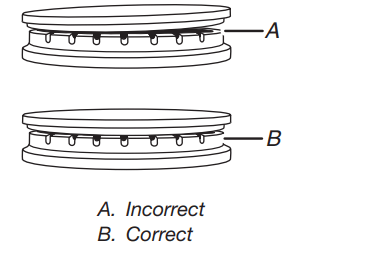
- Turn on the burner. If the burner does not light, check cap alignment. If the burner still does not light, do not service the sealed burner yourself. Contact a trained repair specialist.
Grates
The grates on this range cover the full width of the cooktop. The 2 grates may interlock (on some models), using the hook formed into 1 end of both grates. The flat end of 1 grate drops onto the hook on the other grate as shown in the following illustration.
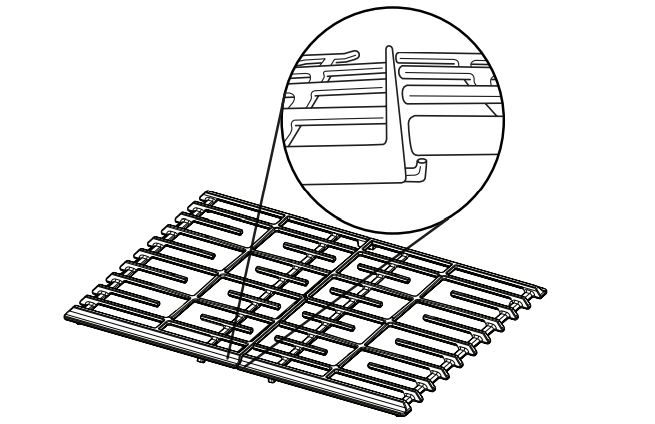
On some models, the 2 grates are identical and can be used on either the left or right side of the cooktop. Grates that are designed for use on only 1 side of the cooktop will have either “LEFT” or “RIGHT” embossed on the bottom side of the grate.
Burner Size
Select a burner that best fits your cookware. See the following illustration and chart.
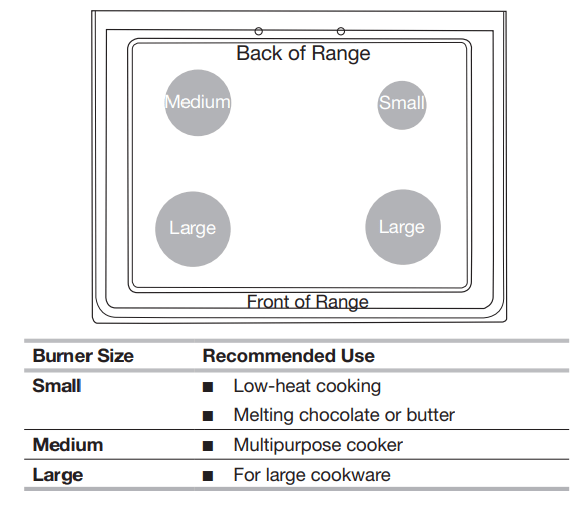
Cookware
IMPORTANT: Do not leave empty cookware on a hot surface cooking area, element, or surface burner. Ideal cookware should have a flat bottom, straight sides, and a well-fitting lid, and the material should be of medium-to-heavy thickness.
Rough finishes may scratch the cooktop. Aluminum and copper may be used as a core or base in cookware. However, when used as a base, they can leave permanent marks on the surfaces.
Cookware material is a factor in how quickly and evenly heat is transferred which affects cooking results. A nonstick finish has the same characteristics as its base material. For example, aluminum cookware with a nonstick finish will take on the properties of aluminum.
Cookware with nonstick surfaces should not be used under the broiler.
Check for flatness by placing the straight edge of a ruler across the bottom of the cookware. While you rotate the ruler, no space or light should be visible between it and the cookware. Use the following chart as a guide for cookware material characteristics.

Aluminum
- Heats quickly and evenly.
- Suitable for all types of cooking
- Medium or heavy thickness is best for most cooking tasks.
- May leave aluminum residues which may be diminished if cleaned immediately after cooking.
Cast iron
- Heats slowly and evenly.
- Good for browning and frying
- Maintains heat for slow cooking.
- Rough edges or burrs may scratch the cooktop.
Ceramic or ceramic glass
- Follow manufacturer’s instructions.
- Heats slowly, but unevenly.
- Ideal results on low to medium heat settings
- May scratch the cooktop.
Copper
- Heats very quickly and evenly.
- May leave copper residues which may be diminished if cleaned immediately after cooking.
- Can leave a permanent stain or bond to the cooktop if overheated.
Earthenware/ Stoneware
- Follow manufacturer’s instructions.
- Use on low heat settings.
Porcelain enamel-on-steel or cast iron
- See stainless steel or cast iron.
Stainless steel
- Heats quickly, but unevenly.
- A core or base of aluminum or copper on stainless steel provides even heating.
For best results, the cookware should be centered above the burner with the bottom sitting level on the grate. The flame should be adjusted so that it does not extend up the sides of the pan.
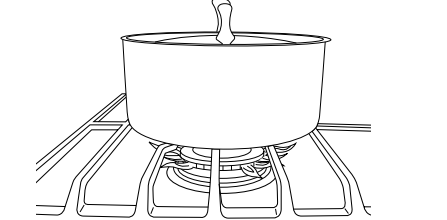
Home Canning
Canning can be performed on a glass smoothtop cooking surface or traditional coil element cooktop. When canning for long periods, alternate the use of surface cooking areas or elements between batches. This allows time for the most-recently used areas to cool.
- Center the canner on the grate above the burner
- Do not place canner on 2 surface cooking areas or elements at the same time.
- For more information, contact your local agricultural extension office or refer to published home canning guides. Companies that manufacture home canning products can also offer assistance.
OVEN USE
The normal operation of the range will include several noises that may be heard each time the Bake or Broil burners ignite during the cooking cycle:
- Gas valves may make a “popping” sound when opening or closing.
- Igniters will “click” several times until a flame is sensed. A “poof” sound is heard when a bake or broil burner ignites.
Odors and smoke are normal when the oven is used the first few times or when it is heavily soiled.
IMPORTANT: The health of some birds is extremely sensitive to the fumes given off. Exposure to the fumes may result in death to certain birds. Always move birds to another closed and well-ventilated room.
NOTE: The convection fan will shut off when the oven door is opened. If the oven door remains open for too long, the heating elements will shut off until the oven door is closed. All timers, including any active Cook Time or Timed Cook functions, will continue to count down.
Electronic Oven Controls
Control Display
The display will flash when powered up or after a power loss. Press OFF/CANCEL to clear. When oven is not in use, the time of day is displayed. Indicator lights show functions that are in use.
Tones
Tones are audible signals, indicating the following:
Basic Functions
One Tone
- Valid keypad press
- Oven is preheated (long tone).
- Function has been entered.
- Reminder, repeating every 20 seconds after the end-of-cycle tones
Three Tones
- Invalid keypad press
Four Tones
- End of cycle
Fahrenheit and Celsius
The temperature is preset at Fahrenheit, but it can be changed to Celsius.
To change: Press and hold the Temp/Time up arrow keypad for 5 seconds. “°C” or “°F” will appear on the display. Repeat to change back.
To exit mode, press the Cancel keypad
Keypress Tones
Activates or turns off the tones when a keypad is pressed.
To change: Press and hold OVEN LIGHT for 5 seconds. Repeat to change back. To exit mode, press OFF/CANCEL.
Demo Mode
IMPORTANT: This feature is intended for use on the sales floor with 120 V power connection and permits the control features to be demonstrated without heating elements turning on. If this feature is activated, the oven will not work.
To change: Press OFF/CANCEL, OFF/CANCEL, the Temp/Time “up” arrow keypad, TIMER SET•OFF. Repeat to change back and end Demo mode.
Oven Temperature Control
IMPORTANT: Do not use a thermometer to measure oven temperature. Elements will cycle on and off as needed to provide consistent temperature but may run slightly hot or cool at any point in time due to this cycling. Most thermometers are slow to react to temperature change and will not provide an accurate reading due to this cycling.
The oven provides accurate temperatures; however, it may cook faster or slower than your previous oven, so the temperature can be adjusted to personalize it for your cooking needs. It can be changed in Fahrenheit or Celsius.
To Adjust Oven Temperature:
- Press and hold the Temp/Time “down” arrow keypad for 5 seconds until the oven display shows the current setting, for example “0°F CAL” or “00.”
- Press the Temp/Time “up” or “down” arrow keypad to increase or decrease the temperature in 5°F (3°C) amounts. The adjustment can be set between 30°F (18°C) and -30°F (-18°C).
- Press START.
Sabbath Mode (on some models)
For guidance on usage and a complete list of models with Sabbath mode
The Sabbath mode sets the oven to remain ON in a Bake setting until turned off. The Oven Control Lockout feature will be disabled during the Sabbath mode. After the Sabbath mode is set, no tones will sound, the display will not show the temperature, the Kitchen Timer mode will be canceled (if active), and only the following keypads will function:
- Temp/Time “up” and “down” arrow keypads
- Off/Cancel
When the oven door is opened or closed, the oven light will not turn on or off and the heating elements will not turn on or off immediately.
When power is restored after a power failure, the oven will return to Sabbath mode and remain Sabbath compliant with the bake elements OFF until Off/Cancel is pressed.
Pressing OFF/CANCEL at any time returns the oven to the normal cooking mode (not Sabbath compliant). Before entering the Sabbath mode, it must be decided if the oven light is to be ON or OFF for the entire Sabbath mode period. If the light is ON when entering Sabbath mode, it will remain ON for the entire time Sabbath mode is in use. If the light is OFF when entering Sabbath mode, it will remain OFF for the entire time Sabbath mode is in use. Opening the oven door or pressing OVEN LIGHT will not affect the oven light once Sabbath mode has been entered.
On the Holiday, the oven temperature can be changed once the oven is in Sabbath mode by pressing the Temp/Time “up” or “down” arrow keypad. The oven temperature will change 25°F (14°C) each time the Temp/Time “up” or “down” arrow keypad is pressed. Press START to activate the new temperature. The display will not change and there will be no sounds during this adjustment.
To Activate and Bake Using Sabbath Mode:
- Press BAKE.
- Press the Temp/Time “up” or “down” arrow keypad.
- Press START.
- Press and hold TIMER SET•OFF for 5 seconds. “SAb” will flash in the display.
- Press START while “SAb” is flashing to enter Sabbath mode; otherwise, the entire cycle cancels out. “SAb” will stop flashing and remain on in the display. The oven is now in Sabbath mode and is Sabbath compliant.
Pressing OFF/CANCEL at any time returns the oven to the normal cooking mode (not Sabbath compliant).
NOTE: If “SAb” does not appear in your display, the Sabbath mode is not active. After Sabbath mode is deactivated, you must activate Sabbath mode by completing steps 1 through 5.
Warm
NOTE: The convection fan will shut off when the oven door is opened. If the oven door remains open for too long, the heating elements will shut off until the oven door is closed. All timers, including any active Cook Time or Timed Cook functions, will continue to count down.
IMPORTANT: Food must be at serving temperature before placing it in the warmed oven. Food may be held up to 1 hour; however, breads and casseroles may become too dry if left in the oven during the Warm function. For best results, cover food. The Warm feature allows hot cooked foods to stay at serving temperature.
To Use:
- Press WARM.
- Press the Temp/Time “up” or “down” arrow keypad until desired temperature is reached. A tone will sound if the minimum or maximum temperature is reached.
- Press START.
- Place food in the oven.
- Press OFF/CANCEL when finished.
NOTE: The temperature may be changed at any time by pressing the Temp/Time “up” or “down” arrow keypad to reach the desired temperature and then pressing START.
Aluminum Foil
IMPORTANT: To avoid permanent damage to the oven bottom finish, do not line the oven bottom with any type of foil or liner. For best cooking results, do not cover entire oven rack with foil because air must be able to move freely.
Positioning Racks and Bakeware
IMPORTANT: To avoid permanent damage to the porcelain finish, do not place food or bakeware directly on the oven door or bottom.
Bakeware
To cook food evenly, hot air must be able to circulate. Allow 2" (5 cm) of space around bakeware and oven walls. Make sure that no bakeware piece is directly over another.
Racks
- Position racks before turning on the oven.
- Do not position racks with bakeware on them.
- Make sure racks are level.
To move a rack, pull it out to the stop position, raise the front edge, and then lift out. Use the following illustration as a guide.

Rack Positions
Rack 5: Toasting bread or broiling thin, non-fatty foods
Rack 4: 2-rack baking and broiling
Rack 3: Most baked goods on a cookie sheet, muffin pan, or jelly roll pan; layer cakes; broiling chicken pieces Rack 2: Pies, casseroles, yeast bread, quick breads, frozen convenience foods, 2-rack baking
Rack 1: Roasting large and small cuts of meat and poultry
Multiple Rack Cooking
2-rack: Use rack positions 2 and 5.
Baking Layer Cakes on 2 Racks
For best results when baking cakes on 2 racks, place flat racks in positions 2 and 5. Place the cakes on the racks as shown.

Baking Cookies
For best results when baking cookies on 2 racks, place flat racks in positions 2 and 5.
Oven Vent

The oven vent releases hot air and moisture from the oven and should not be blocked or covered. Blocking or covering the oven vent will cause poor air circulation, affecting cooking and cleaning results. Do not set plastics, paper, or other items that could melt or burn near the oven vent.
On coil element models, the element can be used when the oven is in use as long as the cookware does not extend more than 1 /2" (1.3 cm) over the element.
Baking and Roasting
Before baking and roasting, position racks according to the “Positioning Racks and Bakeware” section. When roasting, it is not necessary to wait for the oven preheat cycle to end before putting food in unless it is recommended in the recipe.
Preheating
When START is pressed, the oven will begin preheating. Once 100ºF (38ºC) is reached, the display temperature will increase as the actual temperature of the oven increases. When the preheat temperature is reached, a tone will sound, and the selected temperature will appear on the display.
Oven Temperature
While in use, the oven elements will cycle on and off as needed to maintain a consistent temperature, but they may run slightly hot or cool at any point in time due to this cycling. Opening the oven door while in use will release the hot air and cool the oven which could impact the cooking time and performance. It is recommended to use the oven light to monitor cooking progress.
NOTE: On models with convection, the convection fan may run in the non-convection bake mode to improve oven performance.
Temperature Management System
The Temperature Management System electronically regulates the oven heat levels during preheat and bake to maintain a precise temperature range for optimal cooking results. The bake and broil elements or burners cycle on and off in intervals. On convection range models, the fan will run while preheating and may be cycled on and off for short intervals during Bake to provide the best results. This feature is automatically activated when the oven is in use.
Broiling
NOTE: The convection fan will shut off when the oven door is opened. If the oven door remains open for too long, the heating elements will shut off until the oven door is closed. All timers, including any active Cook Time or Timed Cook functions, will continue to count down.
Position food on grid in a broiler pan, and then place it in the center of the oven rack.
Changing the temperature when broiling allows more precise control when cooking. The lower the broil setting, the slower the cooking. Thicker cuts and unevenly shaped pieces of meat, fish, and poultry may cook better at lower broil settings. Use racks 4 or 5 for broiling. Refer to the “Positioning Racks and Bakeware” section for more information.
- For best results, use a broiler pan and grid. It is designed to drain juices and help avoid spatter and smoke. If you would like to purchase a broiler pan, one may be ordered. See the “Accessories” section.
NOTE: Odors and smoke are normal the first few times the oven is used or if the oven is heavily soiled.
RANGE CARE
Self-Cleaning Cycle (on some models)
 WARNING: Burn Hazard
WARNING: Burn Hazard
Do not touch the oven during the Self-Cleaning cycle. Keep children away from oven during Self-Cleaning cycle.
Failure to follow these instructions can result in burns.
IMPORTANT: The health of some birds is extremely sensitive to the fumes given off during the Self-Cleaning cycle. Exposure to the fumes may result in death to certain birds. Always move birds to another closed and well-ventilated room.
Do not block the oven vent(s) during the Self-Cleaning cycle. Air must be able to move freely. Depending on your model, see the “Oven Vent” section. Do not clean, rub, damage, or move the oven door gasket.
Prepare Range
- Remove the broiler pan, grid, cookware and bakeware, all cooking utensils, oven racks, and aluminum foil and, on some models, the temperature probe from the oven.
- Use a damp cloth to clean inside door edge and the 11 /2" (3.8 cm) area around the inside oven cavity frame, being certain not to move or bend the gasket.
- Remove plastic items from the cooktop because they may melt.
- Remove all items from the storage drawer
How the Cycle Works
IMPORTANT: The heating and cooling of porcelain on steel in the oven may result in discoloring, loss of gloss, hairline cracks, and popping sounds.
Before Self-Cleaning, make sure the door is completely closed or the door will not lock and the Self-Cleaning cycle will not begin.
Once the oven has completely cooled, remove ash with a damp cloth. To avoid breaking the glass, do not apply a cool damp cloth to the inner door glass before it has completely cooled.
To stop the self-cleaning cycle at anytime, press OFF/CANCEL.
If the temperature is too high, the oven door will remain locked and “cool” and “locked” will be displayed. The cooling fan may continue to run.
Once the cleaning temperature has been reached, the electronic control requires a 12-hour delay before another Self-Cleaning cycle can be started.
The oven light will not function during the Self-Cleaning cycle
Electronic Oven Control with Adjustable Clean Time (on some models)
The Self-Cleaning cycle is time adjustable between 2 hours 30 minutes and 4 hours 30 minutes in 30-minute increments. Suggested clean times are 2 hours 30 minutes for light soil, and 4 hours 30 minutes for heavy soil.
To Self-Clean:
- Press CLEAN.
- Press the Temp/Time “up” or “down” arrow keypad to enter the desired Self-Cleaning cycle time.
- Press START. The oven door will automatically lock. The Door Locked and Clean indicator lights will be displayed. The time remaining will also be displayed.
- When the Self-Cleaning cycle is complete and the oven cools, the Door Locked and Clean indicator lights will turn off.
- When the oven is completely cooled, remove ash with a damp cloth. To exit the Self-Cleaning cycle before completed, press OFF/CANCEL. The door will unlock once the oven cools.
General Cleaning
IMPORTANT: Before cleaning, make sure all controls are OFF and the oven and cooktop are cool. Always follow label instructions on cleaning products.
Soap, water, and a soft cloth or sponge are suggested first unless otherwise noted.
EXTERIOR PORCELAIN ENAMEL SURFACES (on some models)
Food spills containing acids, such as vinegar and tomato, should be cleaned as soon as the entire range is cool. These spills may affect the finish.
Cleaning Method:
- Glass cleaner, mild liquid cleaner, or nonabrasive scrubbing pad: Gently clean around the model/serial/rating plate because scrubbing may remove numbers.
- Affresh® Kitchen and Appliance Cleaner Part Number W10355010 (not included): See the “Accessories” section for more information.
STAINLESS STEEL (on some models)
NOTE: To avoid damage to stainless steel surfaces, do not use soap-filled scouring pads, abrasive cleaners, Cooktop Cleaner, steel-wool pads, gritty washcloths, or abrasive paper towels. Damage may occur to stainless steel surfaces, even with one-time or limited use.
Cleaning Method:
Rub in direction of grain to avoid damaging.
Affresh® Stainless Steel Cleaner Part Number W10355016 (not included): See the “Accessories” section for more information.
METALLIC PAINT (on some models)
Do not use abrasive cleaners, cleaners with bleach, rust removers, ammonia, or sodium hydroxide (lye) because paint surface may stain.
PORCELAIN-COATED GRATES AND CAPS
Food spills containing acids, such as vinegar and tomato, should be cleaned as soon as the cooktop, grates, and caps are cool. These spills may affect the finish.
To avoid chipping, do not bang grates and caps against each other or hard surfaces such as cast iron cookware.
Do not reassemble caps on burners while wet.
Do not clean in the Self-Cleaning cycle.
Cleaning Method:
- Nonabrasive plastic scrubbing pad and mildly abrasive cleanser: Clean as soon as cooktop, grates, and caps are cool.
- Dishwasher (grates only, not caps): Use the most aggressive cycle. Cooked-on soils should be soaked or scrubbed before going into a dishwasher.
- Gas Grate and Drip Pan Cleaner Part Number 31617 (not included): See the “Accessories” section for more information.
SURFACE BURNERS
See the “Sealed Surface Burner” section
COOKTOP CONTROLS
To avoid damage to the cooktop controls, do not use steel wool, abrasive cleansers, or oven cleaner. To avoid damage, do not soak knobs. When replacing knobs, make sure knobs are in the Off position. On some models, do not remove seals under knobs.
Cleaning Method:
- Soap and water: Pull knobs straight away from control panel to remove.
CONTROL PANEL AND OVEN DOOR EXTERIOR
To avoid damage to the control panel, do not use abrasive cleaners, steel-wool pads, gritty washcloths, or abrasive paper towels.
Cleaning Method:
- Glass cleaner and soft cloth or sponge: Apply glass cleaner to soft cloth or sponge, not directly on panel.
- Affresh® Kitchen and Appliance Cleaner Part Number W10355010 (not included): See the “Accessories” section for more information.
OVEN RACKS
Cleaning Method:
- Steel-wool pad
- For racks that have discolored and are harder to slide, a light coating of vegetable oil applied to the rack guides will help them slide.
STORAGE DRAWER
Check that storage drawer is cool and empty before cleaning.
Cleaning Method:
- Mild detergent
OVEN CAVITY
Do not use oven cleaners on models with a Self-Cleaning cycle. Food spills should be cleaned when oven cools. At high temperatures, foods react with porcelain. Staining, etching, pitting, or faint white spots can result.
Cleaning Method:
- See “Self-Cleaning Cycle” section.
Oven Light
The oven light is a standard 40-watt appliance bulb. Before replacing, make sure the oven and cooktop are cool and the control knobs are in the Off position.
To Replace:
- Unplug range or disconnect power.
- Turn the glass bulb cover in the back of the oven counterclockwise to remove.
- Turn bulb counterclockwise to remove from socket.
- Replace bulb, then bulb cover by turning clockwise.
- Plug in range or reconnect power
TROUBLESHOOTING
| Problem | Possible Causes and/or Solutions |
| Nothing will operate | Power supply cord is unplugged: Plug into a grounded 3 prong outlet. Household fuse is blown or a circuit breaker is tripped: Replace the fuse or reset the circuit breaker. If the problem continues, call an electrician. Main or regulator gas shutoff valve is in the Off position: See the Installation Instructions. The range is improperly connected to the gas supply: Contact a trained repair specialist or see Installation Instructions |
| Surface burners will not operate | Oven is not in Self-Cleaning cyle: Surface burners will not operate during Self-Cleaning cycle. The control knob is not set correctly: Push in knob before turning to a setting. Air in the gas lines: If this is the first time the surface burners have been used, turn on any one of the surface burner knobs to release air from the gas lines. Clogged burner ports: See the “Sealed Surface Burners” section. |
| Surface burner flames are uneven, yellow, and/or noisy | Clogged burner ports: See the “Sealed Surface Burners” section. Burner caps positioned improperly: See the “Sealed Surface Burners” section. Range converted improperly: If propane gas is being used, contact a service technician or see the “Warranty” section for contact information. |
Excessive heat around cookware on cooktop | Cookware that is not the proper size: The cookware should be centered above the burner with the bottom sitting level on the grate. The flame should be adjusted so that it does not extend up the sides of the pan. |
Cooktop cooking results not what expected | Improper cookware: Ideal cookware should have a flat bottom, straight sides, and a well-fitting lid, and the material should be of a medium-to-heavy thickness. Control knob set to incorrect heat level: See the “Cooktop” section. Range is not level: Level the range. See the Installation Instructions. |
Oven will not operate | Air in the gas lines: If this is the first time the oven has been used, turn on any one of the surface burner knobs to release air from the gas lines. Electronic oven control set incorrectly: See the “Electronic Oven Controls” section. |
Oven burner flames are yellow or noisy | Range converted improperly: If propane gas is being used, contact a service technician or see the “Warranty” section for contact information. |
Oven temperature too high or too low | Oven temperature needs adjustment: See the “Oven Temperature Control” in the “Electronic Oven Controls” section. |
Convection fan not turning on | The convection cycle is in the first 5 minutes of operation: This is normal. The convection fan will start running approximately 5 minutes into the cycle. Oven door is open: If the oven door is opened during convection cooking, the fan will turn off immediately. It will come back on when the oven door is closed. |
Heating elements have shut off | Oven door was open for too long: If the oven door remains open for too long, the heating elements will shut off until the oven door is closed. |
Display shows messages | Power failure (Display shows flashing time.): Clear the display. On some models, reset the clock, if needed. See “Clock” keypad feature in the “Feature Guide” section. Error code (Display shows letter followed by number.): Press OFF/CANCEL to clear the display. See “Control Display” in the “Electronic Oven Controls” section. If it reappears, call for service. See the “Warranty” section for contact information. Start needs to be pressed so a cycle can begin (Display shows “PRESS START”.): See the “Start” keypad feature in the “Feature Guide” section. |
Self-Cleaning cycle will not operate | The oven door is open: Close the oven door all the way. The function has not been entered: See the “Self-Cleaning Cycle” section. The Self-Cleaning cycle has been run in the past 12 hours: If a Self-Cleaning cycle has been run, or canceled after the oven has reached temperature, you will have to wait 12 hours to restart. |
Oven cooking results not what expected | Range is not level: Level the range. See the Installation Instructions. The set temperature was incorrect: Double-check the recipe in a reliable cookbook. Oven temperature is calibrated incorrectly: See “Oven Temperature Control” in the “Electronic Oven Controls” section. Oven was not preheated: See the “Baking and Roasting” section. Racks were positioned improperly: See the “Positioning Racks and Bakeware” section. Not enough air circulation around bakeware: See the “Positioning Racks and Bakeware” section. Darker browning of food caused by dull or dark bakeware: Lower oven temperature 25°F (15°C) or move rack to a higher position in the oven. Lighter browning of food caused by shiny or light colored bakeware: Move rack to a lower position in the oven. Batter distributed unevenly in pan: Check that batter is level in the pan. Incorrect length of cooking time was used: Adjust cooking time. Oven door was not closed: Be sure that the bakeware does not keep the door from closing. Oven door was opened during cooking: Oven peeking releases oven heat and can result in longer cooking times. Rack is too close to bake burner, making baked items too brown on bottom: Move rack to higher position in the oven. Pie crusts browning too quickly: Use aluminum foil to cover the edge of the crust and/or reduce baking temperature. Foods are overdone or burnt even at low temperatures: Check if the temperature scale has been changed from Fahrenheit to Celcius. See “Fahrenheit and Celcius” in the “Electronic Oven Controls” section. |
Noises
| Problem | Possible Causes and/or Solutions |
| Surface burner making popping noises | Wet burner: Allow it to dry. |
Gas range noises during Bake and Broil operations The following are some normal sounds with the explanations. | These sounds are normal operational noises that can be heard each time the Bake or Broil burners ignite during the cycle. |
Pop | Gas valve is opening or cycling on and will make a single pop when it snaps open from the solenoid. It sounds similar to a suction cup being pulled off of a piece of glass: This is normal. |
Click | The igniters will click several times until the flame is detected. These are short clicking sounds like tapping a nail onto a piece of glass: This is normal. Convection fan relay is cycling on and off (on some models): This is normal. |
Woosh or poof | Bake or Broil burner is igniting: This is normal. |
| Oven burner flames are yellow or noisy | Range converted improperly: If propane gas is being used, contact a service technician or see the “Warranty” section for contact information. |
See other models: AGR5330BAS AGR4230BAW AGG222VDW AZF33X16DW AZC31T15DW
